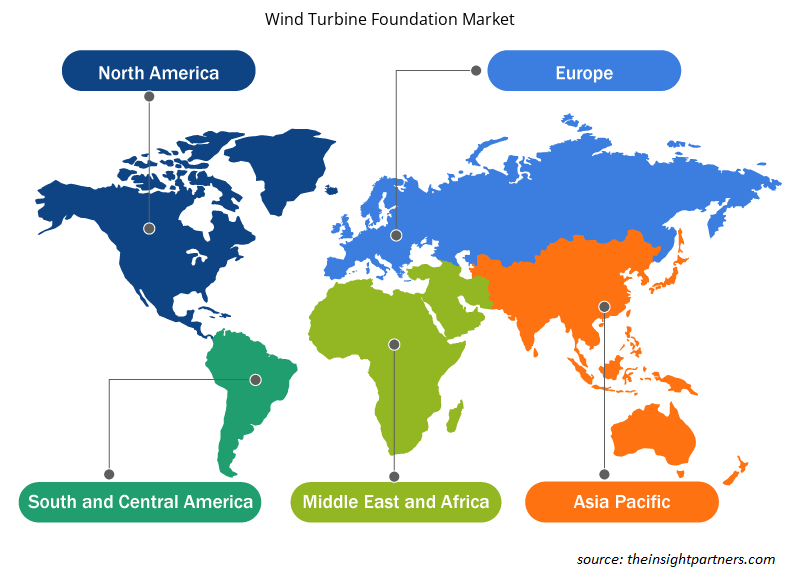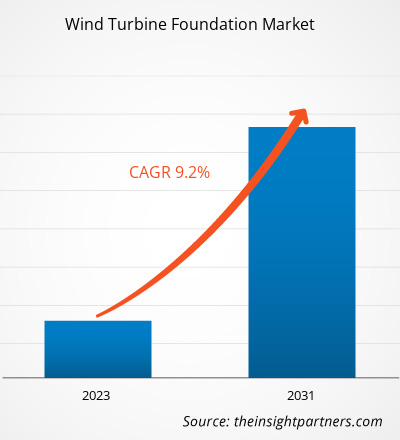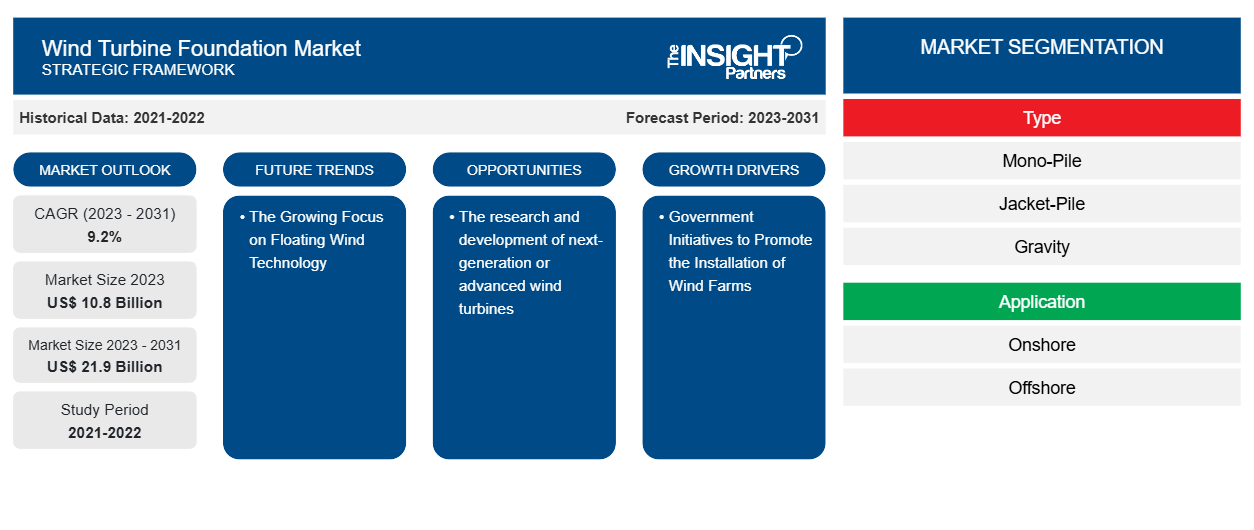風力タービン基礎市場の規模は、2023年の108億米ドルから2031年には219億米ドルに達すると予測されています。市場は2023年から2031年の間に9.2%のCAGRを記録すると予想されています。次世代または高度な風力タービンの研究開発は、市場の主要なトレンドであり続けると思われます。
風力タービン基礎市場分析
風力タービン基礎市場は、特に遠隔地での陸上および洋上風力発電プロジェクトの増加により、分析期間中に大幅な成長を遂げると予想されています。さらに、風力、太陽光、地熱などの再生可能エネルギー源による発電に重点を置くことで炭素排出量を削減するという政府の規制は、2023年から2031年にかけて市場の成長を牽引すると予想されています。さらに、世界中の風力発電所の設置に向けた政府の取り組みは、今後数年間で市場の成長を促進すると予測されています。
風力タービン基礎市場の概要
人口増加と工業化に伴い、エネルギー需要も世界的に高まっています。エネルギー消費の増加により、発展途上国と先進国の両方で再生可能エネルギー発電の必要性が高まりました。その結果、世界中で風力発電インフラの需要が高まっています。風力発電は、他の再生可能エネルギー源と比較して、世界中で高いレベルの重要性と受容性を獲得しています。風力発電ブレード、タービン、基礎、シャフト、その他のコンポーネントの設計と開発における技術の進歩は、風力エネルギーの採用と利用可能な風から最大限の電力を得ることの大きな進歩に貢献しています。国際再生可能エネルギー機関(IRENA)によると、世界の風力発電設備容量は、2021年の825GWから2023年末までに1,017GWに達します。
このように、風力エネルギーの利点と有利な政策、インセンティブ、税還付により、今後数年間で風力発電設備容量のこのような増加が見込まれます。世界中でこのような風力発電設備容量の増加が、風力タービン基礎市場の主要な推進力になると予想されます。
要件に合わせてレポートをカスタマイズする
このレポートの一部、国レベルの分析、Excelデータパックなど、あらゆるレポートを無料でカスタマイズできます。また、スタートアップや大学向けのお得なオファーや割引もご利用いただけます。
-
このレポートの主要な市場動向を入手してください。この無料サンプルには、市場動向から見積もりや予測に至るまでのデータ分析が含まれます。
風力タービン基礎市場の推進要因と機会
市場を有利にする風力発電所の設置を促進する政府の取り組み
分析された期間にわたって、風力エネルギープロジェクトの設置を促進するための政策、補助金、投資の面で、さまざまな国のさまざまな政府からの支援の増加が、風力タービン基盤市場の成長を促進すると予測されています。インド政府は、加速償却のメリットや、風力発電機の特定のコンポーネントに対する特別関税または免税など、さまざまな財政的および財政的インセンティブを提供することにより、民間部門の資金提供を通じて国内の風力発電所の促進に取り組んでいます。たとえば、ドイツは風力エネルギーの拡大を加速するための法案を導入する予定です。新しい法律は、連邦州における陸上風力エネルギーの拡大に拘束力のあるエリア目標を適用します。2022年4月、ドイツは、ドイツのエネルギー政策における最も重大な一連の変更であるイースターパッケージと呼ばれる歴史的なパッケージの助けを借りて、2025年から年間10GWを超える洋上風力目標を展開することを計画しました。これらの政府の取り組みの助けを借りて、2030年までにドイツの電力需要の80%が再生可能エネルギー源からの電力でカバーされることになります。
浮体式風力発電技術への注目の高まり
浮体式風力発電技術とは、海に浮かぶ構造物に取り付けられた洋上風力タービンで、水深のある場所でタービンが発電できるようにします。浮体式または洋上風力発電技術は、厳しい環境条件でも効率が高く、大量の電力を生産することができます。この浮体式風力発電技術は、中国、ドイツ、日本、英国、フランス、ベルギー、デンマークなど、さまざまな国で世界的に採用されています。浮体式風力発電技術の採用における成長見通しは、主に技術の進歩、関連する利点、およびさまざまなサービスプロバイダーが提供するターンキーソリューションの増加に起因しています。さまざまな国でクリーンエネルギー目標を達成するという意識が高まっていることから、浮体式洋上風力発電の需要が高まっており、風力タービン基礎市場の成長に潜在的な機会をもたらしています。
浮体式洋上風力発電センター・オブ・エクセレンス報告書は、新興の再生可能エネルギー技術で主要プレーヤーになる準備が最も整っている22カ国を特定しました。2022年1月、英国政府は、英国で生成される再生可能エネルギーを増やすために29億7,000万米ドルを投じ、それぞれ最大9億5,923万米ドルを授与する11の再生可能エネルギー発電プロジェクトを発表しました。世界中での洋上または浮体式風力発電技術へのこのような投資は、今後数年間の市場成長を促進すると予測されています。
風力タービン基礎市場レポートのセグメンテーション分析
風力タービン基礎市場分析の導出に貢献した主要なセグメントは、タイプとアプリケーションです。
- タイプに基づいて、風力タービン基礎市場は、モノパイル、ジャケットパイル、重力、三脚、吸引、ラフト、パイル、井戸基礎、岩とアンカー、その他に分類されます。重力セグメントは2023年に大きな市場シェアを占めました。
- アプリケーションに基づいて、市場は陸上と海上に分類されます。陸上セグメントは2023年に大きな市場シェアを占めました。
風力タービン基礎市場シェアの地域別分析
風力タービン基礎市場レポートの地理的範囲は、主に北米、アジア太平洋、ヨーロッパ、中東およびアフリカ、南米および中米の 5 つの地域に分かれています。
2023年の風力タービン基礎市場はアジア太平洋地域が支配しました。アジア太平洋地域には、中国、オーストラリア、インド、韓国、日本、およびその他のアジア太平洋地域が含まれます。アジア太平洋地域は、2023年に世界の風力タービン基礎市場で最大の市場シェアを占め、予測期間中に最速のCAGRで拡大すると予想されています。堅調な陸上産業と、この地域全体に多数の風力タービン基礎メーカーが存在することが、高い市場シェアの原因です。さらに、中国、日本、韓国、東南アジアのオフショア部門の拡大により、地域全体の風力タービン基礎ベンダーの市場が拡大しています。さらに、この地域での陸上および洋上風力発電所の設置に向けた投資の増加により、今後数年間で風力タービン基礎の需要が促進されると予測されています。
風力タービン基礎市場の地域別洞察
予測期間を通じて風力タービン基礎市場に影響を与える地域的な傾向と要因は、Insight Partners のアナリストによって徹底的に説明されています。このセクションでは、北米、ヨーロッパ、アジア太平洋、中東、アフリカ、南米、中米にわたる風力タービン基礎市場のセグメントと地理についても説明します。

- 風力タービン基礎市場の地域別データを入手
風力タービン基礎市場レポートの範囲
| レポート属性 | 詳細 |
|---|---|
| 2023年の市場規模 | 108億米ドル |
| 2031年までの市場規模 | 219億米ドル |
| 世界のCAGR(2023年~2031年) | 9.2% |
| 履歴データ | 2021-2022 |
| 予測期間 | 2023-2031 |
| 対象セグメント |
タイプ別
|
| 対象地域と国 |
北米
|
| 市場リーダーと主要企業プロフィール |
|
風力タービン基盤市場のプレーヤー密度:ビジネスダイナミクスへの影響を理解する
風力タービン基礎市場は、消費者の嗜好の変化、技術の進歩、製品の利点に対する認識の高まりなどの要因により、エンドユーザーの需要が高まり、急速に成長しています。需要が高まるにつれて、企業は提供を拡大し、消費者のニーズを満たすために革新し、新たなトレンドを活用し、市場の成長をさらに促進しています。
市場プレーヤー密度とは、特定の市場または業界内で活動している企業または会社の分布を指します。これは、特定の市場スペースに、その市場規模または総市場価値に対してどれだけの競合相手 (市場プレーヤー) が存在するかを示します。
風力タービン基礎市場で事業を展開している主要企業は次のとおりです。
- フグロ
- ランボルグループA/S
- イベルドローラSA
- BW イデオル
- ペイコグループ
- EEWグループ
免責事項:上記の企業は、特定の順序でランク付けされていません。

- 風力タービン基礎市場のトップキープレーヤーの概要を入手
風力タービン基礎市場のニュースと最近の動向
風力タービン基礎市場は、主要な企業出版物、協会データ、データベースを含む一次調査と二次調査後の定性的および定量的データを収集することによって評価されます。風力タービン基礎市場におけるいくつかの開発を以下に示します。
- Odfjell Oceanwind は Prodtex と提携しました。この提携は、2027 年までに施設を開設することを目指して、浮体式風力発電基礎の生産能力を拡大することを目的としていました。(出典: Odfjell Oceanwind、プレスリリース、2024 年 2 月)
- Principle Power は、WindFloat F という新しいフラットパネルのポンツーンベースの浮体式風力発電基礎を発表しました。この基礎は、港湾での超浅い風力タービンの統合用に設計されています (出典: Principle Power、プレスリリース、2023 年 9 月)
風力タービン基礎市場レポートの対象範囲と成果物
「風力タービン基礎市場の規模と予測(2021〜2031年)」レポートでは、以下の分野をカバーする市場の詳細な分析を提供しています。
- 風力タービン基礎市場の規模と予測(世界、地域、国レベルで)
- 風力タービン基礎市場の動向、推進要因、制約、主要な機会などの市場動向
- 詳細なPESTおよびSWOT分析
- 主要な市場動向、世界および地域の枠組み、主要プレーヤー、規制、最近の市場動向を網羅した風力タービン基礎市場分析
- 市場集中、ヒートマップ分析、主要プレーヤー、風力タービン基礎市場の最近の動向を網羅した業界展望と競争分析
- 詳細な企業プロフィール
- 過去2年間の分析、基準年、CAGRによる予測(7年間)
- PEST分析とSWOT分析
- 市場規模価値/数量 - 世界、地域、国
- 業界と競争環境
- Excel データセット
最新レポート
関連レポート
お客様の声
購入理由
- 情報に基づいた意思決定
- 市場動向の理解
- 競合分析
- 顧客インサイト
- 市場予測
- リスク軽減
- 戦略計画
- 投資の正当性
- 新興市場の特定
- マーケティング戦略の強化
- 業務効率の向上
- 規制動向への対応























 無料サンプルを入手 - 風力タービン基礎市場
無料サンプルを入手 - 風力タービン基礎市場